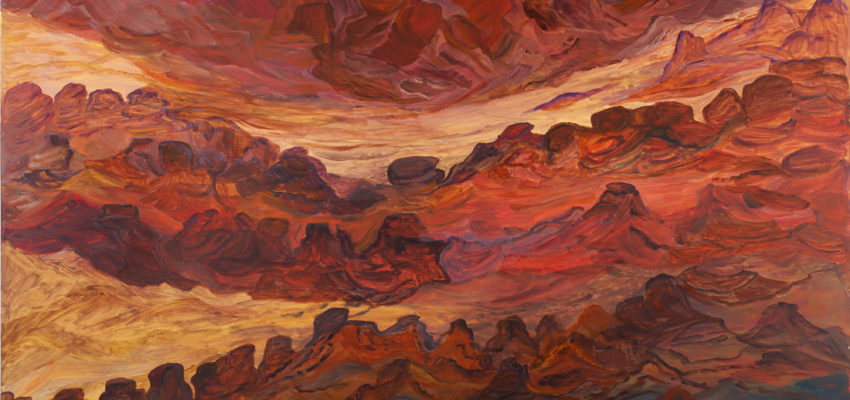Gazing across the nation’s landscape, artists have referenced the past, the future and the ever present to identify and give a sense of place to the space they occupy. The experience can be grounded in the physical reality of a site, along with its deep, often-elusive spiritual associations. Country & Western: landscape re-imagined brings into focus the contrasting insights and cultural imperatives, both Indigenous (Country) and non-Indigenous (Western), that have given shape and substance to our evolving attitudes and perceptions of the national landscape over the past 25 years. To grasp an appreciation of the enterprise, a timeframe was established. As a consequence, the works assembled for Country & Western are all post bicentennial pieces.
In traversing the Australian landscape through a disparate body of work by a significant group of 39 artists working in various media, the exhibition reaffirms the impact landscape exerts on the national psyche. In recent decades, the world has come to accept Indigenous art as the authentic, defining image of the Australian landscape – a landscape famously re-invigorated by its original custodians. In the early 1970s, the Papunya Tula painting movement transformed the direction of Australian art, in particular, Australian painting.
With the focus back on the national landscape in all its complexity, now is the time to assess the relevance of western landscape traditions in response to the Indigenous vision, and search out common ground (if any). As well, the vexed issues of dispossession, identity, collaboration, mining and land degradation along with the elemental impact of fire and rain and the country’s natural splendour are all viewed from differing cultural perspectives.
What has become apparent in the work of the non-Indigenous artists is the depth of the emotional response they had to various sites. That hard-won grasp of the character of a place with its history and inter-connected landscape systems underpinned the quality of the work. In recent times, respect and an evolving apprehension of Indigenous culture has enhanced the western landscape tradition in Australian art.
The exhibition tour has been organised by the Perc Tucker Regional Gallery. After Sydney it heads to the Blue Mountains City Art Gallery (8 January – 6 March 2016); Wagga Wagga Regional Art Gallery (19 March – 8 May 2016); Mornington Peninsula Regional Gallery (VIC); Orange Regional Gallery (NSW); Cairns Regional Gallery (QLD); with the final venue, Museum and Art Gallery of the Northern Territory opening in November 2016.
Artists include: Tate Adams, Paddy Bedford, Jason Benjamin, Jo Bertini, Elisabeth Cummings, Shane Fitzgerald, Angelina George, John Gollings, Julie Harris, Gertie Huddleston, Tim Johnson, Emily Kame Kngwarreye, Joanna Logue, Euan Macleod, Mandy Martin, Claudine Marzik, Ricky Maynard, Ron McBurnie, Noel McKenna, Andrew Merry, Tracey Moffatt, Idris Murphy, Angus Nivison, John Olsen, Tommy Pau, John Peart, Ginger Riley Munduwalawala, Brian Robinson, William Robinson, Anneke Silver, Ken Thaiday Snr, Patrick Thaiday, Rover Thomas, Imants Tillers, Ronnie Tjampitjinpa, John R Walker, Ken Whisson, Mulkum Wirrapanda and John Wolseley.
Public Programs
Sunday 8 November at 3pm Exhibiting artist Jo Bertini discusses her experiences in the desert and her work in the exhibition.
Sunday 15 November at 3pm Gavin Wilson, exhibition curator gives a floor talk about the genesis of the exhibition and the works selected for inclusion.
Sunday 22 November at 3pm Tim Johnson and Julie Harris discuss their works in the exhibition
Sunday 29 November at 3pm Artists Angus Nivison and Andrew Merry discuss how sense of place and climate inform their works in the exhibition.
Sunday 6 December at 3pm Euan Macleod and Idris Murphy experience the landscape in deeply personal way and express their emotional responses in their works

